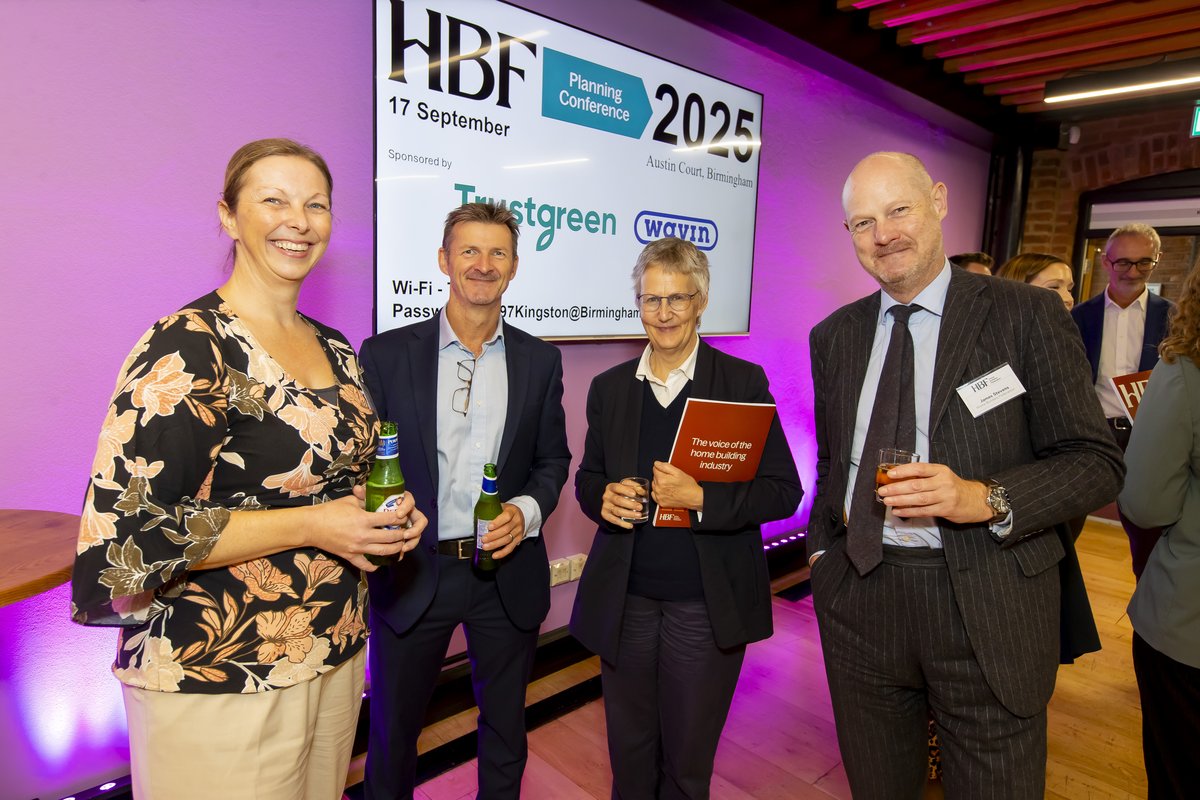Image Gallery




































Presentations
| Rupert Warren KC - Landmark Chambers | Download Presentation |
| Simon Ricketts - Town Legal | Download Presentation |
| Grant Butterworth - Leicester City Council | Download Presentation |
| Kate Tait, Cameron Homes & Mark Skilbeck, Taylor Wimpey | Download Presentation |
| James Stevens - HBF | Download Presentation |
| Emily Williams - Savills | Download Presentation |
| Myles Wild-Smith - Lichfields | Download Presentation |
| Vicky Payne - Future Homes Hub | Download Presentation |
The HBF Planning Conference 2025 took place on 17 September at Austin Court, Birmingham.
The National Planning Policy Framework (NPPF) is opening new avenues into housing delivery but the shift to joined up strategic planning will take time and may need an improved market, according to Emily Williams, Savills’ director, residential research.
Speaking at HBF’s Planning Conference in Birmingham about the impact thus far of the revised NPPF and on the housing market, Williams said that since the introduction of the government’s changes to the NPPF, there had been a notable increase in planning consents achieved by appeal in a “route” to achieving planning approvals.
But the revisions, which were announced in December 2024, were yet to reverse the controversial decisions of the Conservative administration, Williams stated.
Williams said that according to her data, there was “no sign yet of an uptick in applications” or a “shift in the type of sites” following Labour’s revisions. At the same time, data for quarter two, albeit “patchy”, suggested a slight uptick.
The subdued market was also inhibiting planning progress, Williams indicated. “Sales rates are unspectacular. Some housebuilders’ sales rates have dropped significantly.”
And with possible further changes to the NPPF and other upcoming policies including the New Towns programme and devolution, “the market doesn’t like levels of uncertainty”.
But it was unlikely the full capacity of the planning system would be realised “if we don’t tackle demand", Williams said.
“The NPPF is opening up new routes but moving to a system with joined up planning across sensible geographies will take a long time," she stated. The first NPPF, introduced in 2012, did not generate a “real” recovery in planning – “it was only when the market improved”.
Also at the Planning Conference, which saw housing minister Matthew Pennycook tell delegates to “buckle up” for “phase two” of the government’s housing plans, speakers talked of the myriad issues that planning faced.
Mark Skilbeck, Taylor Wimpey’s UK planning director, said the government was “listening” to the housebuilders' challenges but the question was whether it was “acting quickly enough”.
On asks of the government, Skilbeck said he would welcome confirmation that local authorities must meet higher housing need numbers following the NPPF changes. But, as both Skilbeck and Williams agreed, it could take until 2029 for local authorities to produce the required numbers to reach the government’s housing target.
Skilbeck and Kate Tait, group strategic land and planning director of SME Cameron Homes, discussed their experiences of the government’s planning policies and viability.
Tait commented that the regulatory burden for all housebuilders was “coming at us from all angles” with the various requirements being made in isolation of each other. She added: “If 1.5 million homes will save the economy, the development industry is being treated like a cash cow that will pay for it all.”
James Stevens, HBF’s director for cities, gave an update on water and nutrient neutrality, the latter of which the government aims to deal with through the Nature and Restoration Fund, contained within the Planning and Infrastructure Bill.
He also covered wastewater issues which were stalling the delivery of 30,000 homes, according to recent HBF research. “This is a turf war between government and water authorities and [housebuilders] are caught in the middle of it.”
Myles Wild-Smith, Lichfields’ planning director, looked at the “good and bad” of the government’s new concept of grey belt.
Rupert Warren, Landmark Chambers’ barrister, addressed the “relentless pace” of government legislation and policy over the past year, including the Planning and Infrastructure Bill and elements of the Levelling Up and Regeneration Act, both of which were slow processes with their requirement for secondary legislation, he said.
Simon Ricketts, partner of Town Legal, considered the government’s “acceleration package” to speed up the progress of its measures and the part policy could play.
Grant Butterworth, head of planning at Leicester City Council, spoke of the city’s plans for devolution. “If the government sees the agenda through, it will be very positive,” he said. “The risk is how the transition is managed.”
Vicky Payne, the Future Homes Hub’s head of place and nature, offered some positivity against a day of discussing difficulties. Referring to the Hub’s cross-sector, multi-disciplined work, she said: “People focus on pieces of the puzzle but it’s rare to find an organisation that is balancing all of them, particularly nature and housing.”
Speakers
Where
IET Birmingham: Austin Court, 80 Cambridge St, Birmingham B1 2NP

















